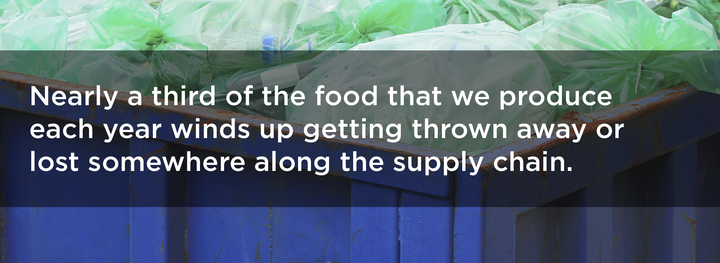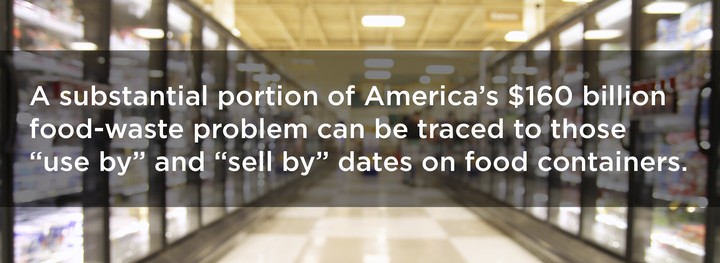Nearly a third of the food that we produce each year winds up getting thrown away or lost somewhere along the supply chain. According to the United Nations, that amounts to about 1.3 billion tons of food that’s squandered annually. And that’s more than merely a shame: Researchers say that preventing food waste and loss will be essential to finding a way to feed the world’s growing population in the years to come.
In a 2014 report, the U.N. High Level Panel of Experts on Food Security and Nutrition, including Friedman School Professor Eileen Kennedy, called for making the prevention of food loss and waste a global priority. “The extent of food losses and waste while more than 800 million people still suffer from hunger seems to indicate that something is wrong, that food systems do not function as they should,” the panel wrote.

Of course, this issue is about more than just hunger. The energy used on wasted food would make it the world’s third-largest producer of greenhouse gases. Waste also carries a hefty economic price tag for food producers—about $750 billion annually, says the U.N. For these reasons, the United States is calling for a 50 percent reduction in food waste and loss by 2030.
WILLING TO WASTE
What motivates people to buy food they don’t intend to eat?
Back in college, when Professor Norbert Wilson would buy a jar of pasta sauce at the supermarket, he had every intention of using it up. But there’s only so much spaghetti a person can eat, which meant those jars occasionally ended up as half-eaten, fuzzy science experiments lurking in the back of his refrigerator.
It was a small example of food waste, but one that stuck with him. Wilson, who joined the Friedman School as a professor of food policy in January, has been investigating food waste, building on his past research on food choice, domestic hunger, food banking and the international trade of food products.
When Wilson turned his attention to issues related to food waste, he theorized that consumers buy food even when they’re aware they may not finish it. It’s a concept that anyone who has purchased a container of sour cream can understand—we buy it knowing we may toss the container with a hefty portion still clinging to the sides. But what motivates people to spend good money on food they don’t intend to eat?
Wilson found a clue in 2013, when the Natural Resources Defense Council released a report showing that a substantial portion of America’s $160 billion food-waste problem could be traced to those “use by” and “sell by” dates on food containers. It turns out that many consumers, worried that food that has passed the date on its packaging is no longer worth eating, throw out plenty of perfectly good stuff. Could consumers be thinking about those labels as they buy the food?

To find out, Wilson devised an experiment that involved putting differently worded date labels on yogurt, cereal and salad greens. The labels used a variety of terms—“use by,” “best by,” “sell by” and “fresh by”—and included an expiration date. Wilson wanted to know whether certain language would result in people buying food with a greater expectation that they would waste some of it—what Wilson and his colleagues called the “willingness to waste.” The 200 participants in the study were asked to examine food carrying the different labels and then say how much of each product they expected their household to consume. In nearly every case, the subjects’ answers indicated that they would be more willing to toss out food if it had the “use by” wording. The researchers theorized that may have been because “use by” implies that the food would no longer be safe to eat after that date.
The study found that date labels were influential even when it came to a food like boxed cereal, which is less vulnerable to spoilage. In fact, the willingness to waste was actually higher for cereal than it was for more perishable items like yogurt and bagged salad. The cereal example also showed that the perception of a bargain can influence willingness to waste amounts. For instance, when participants in the study perceived that they were getting a better deal by buying a larger box of cereal (think Costco-size double boxes of Cheerios), they anticipated wasting more of it, even if the “use by” date was a year in the future. “I was surprised by how strong a response they had to the cereal,” Wilson said, “and that people were willing to waste more when they saw the larger size.” The pitfall for consumers, he said, is that tossing more of the cereal may have canceled out the savings they thought they were getting.
The findings imply that the way foods are packaged can enable waste. Tweaking package sizes may keep consumers from buying more than they’ll eat. But one wide-reaching change would be to standardize date labels—currently unregulated at the federal level—so that they have a consistent meaning. “To move forward on [reducing] food waste,” Wilson said, “we will need collaborations between industry, consumer groups and the government to change labels.” - C.L.
Reprinted with permission, Tufts Nutrition Magazine, copyright 2017, Tufts University
